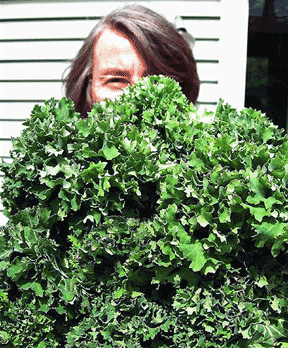Hail, Kale!
Not only is it lovely, it’s the key ingredient in this famous Portuguese soup
by Valerie Lester
The other day, I dashed into the supermarket and came to a screeching halt in front of the most dazzling display of kale I have ever seen, bunches and bunches of straight kale and curly kale, all bursting with vigor. They shouted out to me, It’s time to make that Portuguese soup. An excellent idea.
I set about gathering ingredients, all the while ruminating on recent changes in the vegetable department where bagged vegetables and free-to-roam vegetables have changed places. The bagged ones are now located in the larger premises along the side wall. Bag after vacuum-sealed bag reach as far as the eye can see, while the free-to-roam vegetables are now cheek by jowl in straitened premises near the front entrance. This is a clear case of bagged vegetable expansionism, a movement that has been steadily creeping over vegetable departments throughout the nation.
The good news is that the free-to-roam vegetables are in an eye-grabbing position, and on that particular day, kale was the green and silver centerpiece. This was not any old anemic green; this was a green of exquisite richness and depth, traced with silver veins. How pale, weak and insubstantial the bagged vegetables seemed by comparison. How weakened and withdrawn they were, their bags full of some gas or other to keep them fresh, day after day, week after week.
Bag Full of Gas
I once did an experiment with a bag of Baby Boston Lettuce. It had fallen to me to clear out my sister-in-law’s refrigerator while she was in hospital, and I removed the bag of lettuce, brought it home and stuck it in the vegetable drawer of my fridge. The lettuce gradually moved farther and farther back as I acquired more free-to-roam vegetables, but I checked on it every so often. A week passed, then two, then three and nothing about it seemed to change. It wasn’t until the fourth week that I noticed a tinge of brown on the leaves. In the fifth week, things started to get slimy. I took the bag out of the fridge, and popped it with a knife. It exhaled a fetid breath. I dumped the lettuce into my compost bin and threw away the bag.
Then I did the math. I had the lettuce for five weeks; my sister-in-law had it for a week. It spent a few days on a truck traveling from Florida to the supermarket, more days before that being picked, sorted, bagged, gassed, sent to a central dispatch area, then loaded on the truck. By the time I threw it out, it was close to two months old. For baby lettuce, it certainly had some mileage.
Vegetable Therapy
Back in the supermarket, I decided on straight rather than curly because of its deeper green. I picked up a large bunch, which was fairly bristling with verve. I tossed a couple of pounds of red potatoes into my cart, some onions, two cans of beef consommé, two cans of cannellini beans and a hank of kielbasa. In the bakery department, I picked up a loaf of rosemary sourdough bread.
When I got home, I untwisted the tie that bound the kale together, and the leaves sprang forth in a magnificent display. Running water over them, admiring their veins and corrugation and spraying the dirt from their grooves, I resisted the temptation to put them in a vase. I sniffed their freshness and found myself at peace with all that greenness and complexity of structure.
I believe deeply in vegetable therapy. Like stroking a pet, washing and chopping vegetables can ease stress and lower blood pressure. And, of course, fresh vegetables themselves are what every doctor counsels you consume, with kale at the top of the list.
I poured some olive oil into a large soup kettle and sautéed the onions and the sliced kielbasa. I washed and chopped the smooth, red potatoes. With my sharpest knife (one of those triangular Japanese ones) I chopped the potatoes into inch-sized cubes and tossed them into the pot along with the consommé, two cans of water and the beans.
At last it was time for the kale. I grasped it and held it down on the chopping board (you need a really large board for this to be a satisfying experience). I guillotined off the stalk ends and pushed them away. Then I chop-chop-chopped the kale into bite-sized pieces all the way from bottom to top. It expanded as I chopped and rose up in a huge mound on the board. Then I grasped handfuls and plunged them into the soup kettle, filling it up and over the top.
Quickly I crammed a glass lid on the springy soup and watched as the kale heated up and relaxed into its new environment. I brought the soup up to a boil and back down to a simmer and then let the whole thing putter along for an hour.
That evening, we were six for a dinner of Portuguese soup and rosemary bread. Before we dug in, we poured some red wine, raised our glasses and gave the toast: Hail, glorious kale!
World-traveling Lester, a Brit by birth, writes from Annapolis. Her last story for Bay Weekly was Poinsettias with a Story (Vol. xiv, No. 48: November 30, 2006).
